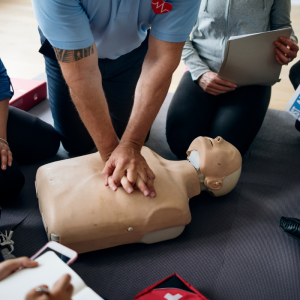Description
This 8 hour Hazardous Waste Operations Emergency Response program is specifically designed to fulfill the following:
- OSHA 29 CFR 1910.120 (HAZWOPER Awareness Level 1); Emergency Action Plan, Spill Prevention/Response
- Hazard Communication [29 CFR 1910.1200]
- Access to Medical Records 29 CFR 1910.1020;
- Accident / Incident Investigation and Reporting
- Bloodborne Pathogens 29 CFR 1910.1030;
- Compressed Gases 29 CFR 1910.252 & 29 CFR 1910.101;
- Confined Space Awareness [9 CFR 1910.146] Inert Gas Space Entry
- D.O.T. – Drug & Alcohol Awareness 49 CFR 199.239;
- Electrical Affected Person 29 CFR 1910 Subpart S;
- Ergonomics OSHA Section 5(a)(1); Fatigue Awareness, Manual Lifting, Heat & Cold
- Fall Prevention & Protection (Including ladders & scaffolds)29 CFR 1926.501;
- Fire Extinguisher Awareness (Portable) 29 CFR 1910.157;
- Hazard Communications 29 CFR 1910.1200;
- Hydrogen Sulfide Awareness API 49/55 & 29 CFR 1910.1000;
- Marine Debris Orientaion as prescribed by BOEM
- Job Safety Analysis 29 CFR 1910.132(d); Stop Work Authority. Hazard I.D. & Risk
- Knife Safety (Alternative Cutting Tools);
- Lockout / Tagout (Affected Employees) (Powered hand tools) 29 CFR 1910.147 Permit to Work (Confined Spaces)
- Noise Exposure 29 CFR 1910.95;
- N.O.R.M. Awareness;
- OSHA General Duty Clause OSHA Section 5(a)(1); Stop Work Authority
- Personal Protective Equipment 29 CFR 1910 Subpart I;
- Respiratory Protective Equipment 29 CFR 1910 Subpart I;
- Slips, Trips & Falls + Overexertion Awareness 29 CFR 1910.21-.30; Fatigue Management
- Toxic & Hazardous Materials in the Workplace (MSDS & Labels) 29 CFR 1910.1001 Waste Management
- Welding, Cutting & Brazing; Hot Work Awareness 29 CFR 1910.252
- Characteristics of Hazardous Materials
- Benzene Awareness
- Toxic Exposure & Regulations
- HMIS & ERG Understanding
- SEMS Awareness [30 CFR 250 Subpart S]
- Written Examination
Course typically offered every Wednesday at 8:00am, or available upon request. Call us at 877.593.8693 to reserve your seat or for more information.
—
Course Outline:
- Medical Statement
- General Patient Primary Assessment
- One Rescuer CPR
- Use of the AED
- Choking
- Control of Bleeding
- Shock Management
- Illness Assessment
- Heart Problems
- Stroke
- Allergic Reactions
- Poisoning
- Diabetic Emergencies
- Epileptic Seizures
- Hyperventilation
- Injury Assessment
- Fractures, Dislocation and Splinting
- Head & Chest Injuries
- Neck & Back Injuries
- Wounds & Bandaging
- Exposure to Cold & Heat
- Burns
- Electrical Injuries
- Emergency Moves
- Psychological Impact of CPR
- Bloodborne Pathogens




